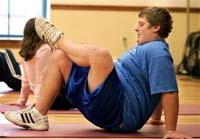Physical activity postpones aging
A new study suggests that physical activity is most effective when speaking about free time. It means that people who prefer active way of spending free time to sedentary one may be biologically younger than their opponents.

A sedentary lifestyle is believed to be a factor in obesity, and, in doing so, may contribute to other diseases, such as type II diabetes, heart disease, depression and even hemorrhoids. Lack of exercise causes muscle atrophy, shrinking and weakening of muscles, which in turn increases susceptibility to injury. Physical fitness is correlated with immune system function, and a reduction in physical fitness is generally accompanied by a weakening of the immune system.
The named aspects contribute to wear and tear of an organism, aging and premature death.
2,401 white twins participated in the study. The researchers took into consideration their physical activity levels, smoking habits and socioeconomic status. They collected DNA samples and studied the length of telomeres-repeated sequences at the end of chromosomes in white blood cells (leukocytes). The number of leukocyte telomeres reduces over time and may serve as a marker of a person's biological age.
The results showed that those people, who prefer sedentary lifestyle had an average telomere loss of 21 nucleotides (structural units) per year. A group of people characterized by an active lifestyle had longer leukocyte telomeres. In other words the most active people had telomeres the same length as sedentary individuals up to 10 years younger. That’s why it’s highly recommended to spend 30 minutes at least five days a week on moderate-intensity physical activity.
The study needs more research and experiments but still advances a sound hypothesis about aging and physical activity.
Subscribe to Pravda.Ru Telegram channel, Facebook, RSS!





